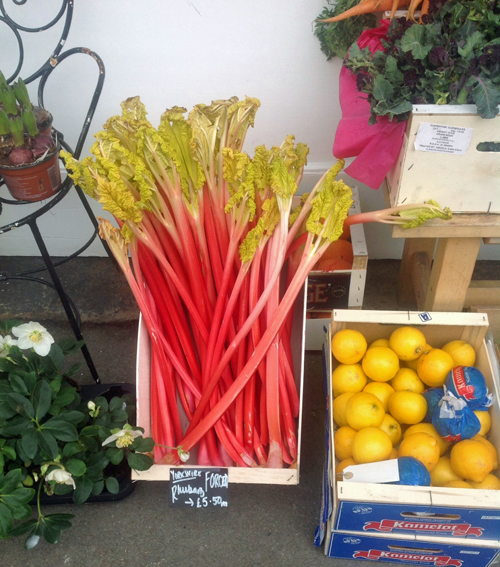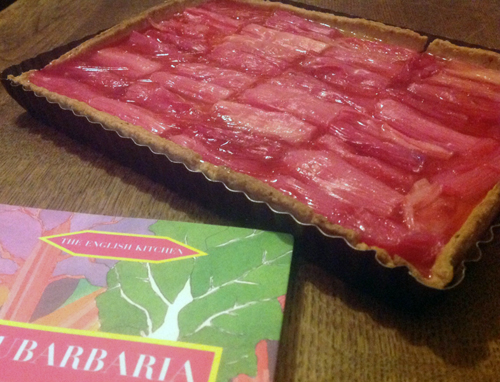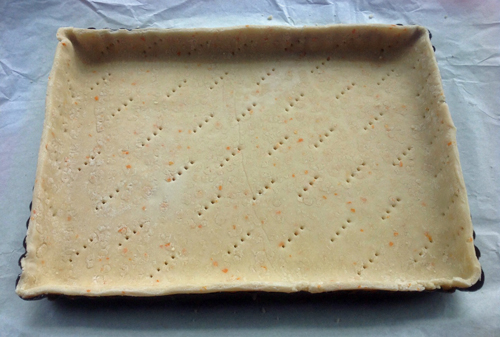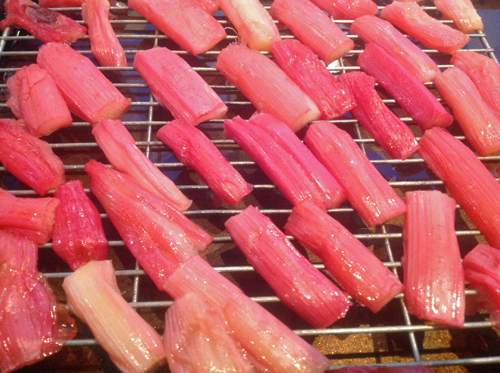Even though it might sound a bit like the the Bermuda Triangle, the Yorkshire Rhubarb Triangle has nothing in common with its Caribbean geometric cousin. Nothing goes mysteriously missing here in Yorkshire. In fact, it is quite mundane. The Yorkshire Rhubarb Triangle is simply a triangular area of land – approximately 9 square miles – in West Yorkshire around the town of Wakefield where specialist farms produce quantities of rhubarb. At certain times of the year, if you’re travelling north towards Leeds or Bradford, you can’t help but notice fields of the distinctive large leafy plants on either side of the highway.
Early in the year, forced rhubarb is produced. This is the tender, blush-red extra-long stems forced into early growth, commercially in heated forcing houses or in kitchen gardens by that ingenious device, the rhubarb forcer. A forcing pot is very tall and open ended, with a lid for the top. It insulates, providing a warm environment tricking the plant into growth, and encourages the stems to reach high up the pot towards the source of light that is controlled by the removal of the lid. The resulting stalks, extremely tender and surprisingly sweet, are long and pale topped by stunted pale yellow leaves.
According to Mary Prior in Rhubarbaria: Recipes for Rhubarb (Prospect Book’s The English Kitchen series), it was the growers in the Yorkshire Rhubarb Triangle who first came up with the notion of forcing rhubarb in the 19th century. The district supplied London with early rhubarb every week from January to March, sending the precious cargo south on a special train. The train, known as The Rhubarb Express, operated up until 1966.
Rhubarb-Orange Tart
Just when you are beginning to tire of dreary winter, there is nothing like a fruit tart to give the illusion of warmer times. This tart takes advantage of the fruits of the season. It is made in three parts – sweet-tart, tender rhubarb layered over a layer of tangy orange curd in a pre-baked pastry shell.
Pastry
-
See my post Georgian Tart for Sweet Orange Shortcrust Pastry.
Make the pastry according to the instructions in my post, A Georgian Tart, substituting the clementine zest for Seville orange zest and water for the orange juice. Since this is all the baking the pastry will get, it may need to bake it a few minutes longer than stated in the instructions. Let cool.
Seville Orange Curd
- 2/3 cup Seville orange juice (approximately 4 oranges)
- 4 oz. butter (1 stick), cut into small pieces
- 1 cup sugar
- 2 large eggs
Make the Seville orange curd by juicing the oranges. Pour the juice into a pan and add the sugar and butter. Heat the mixture so that the sugar dissolves and the butter melts. Meanwhile, beat the eggs in a small bowl. Spoon a little of the orange mixture into the beaten egg, mix. With a whisk, beat the orange mixture while pouring in the beaten egg. Continue to whisk until the egg has been incorporated and the mixture begins to thicken. Lower the heat and continue cooking and stirring for another 10 minutes for a thick curd. This is the same procedure in making a custard. while still warm, pour into the cooled pastry shell and spread evenly. Cool completely.
Rhubarb
- 1-1/2 lb. forced rhubarb (approximately 5 to 6 stalks)
- 1/4 cup sugar
- 2 sheets gelatine (or 1 teaspoon unsweetened gelatine powder)
To make the rhubarb filling, first preheat the oven to 375 degrees F. Clean and chop the stalks into 2 inch pieces. Place the rhubarb in a shallow roasting tray and sprinkle on the sugar, giving the tray a little shake. Cover with foil and bake for 15 minutes before removing the foil cover. Bake for an additional 2 minutes. Drain the rhubarb, reserving any roasting liquids and allowing the rhubarb to cool.
Layer the rhubarb on top of the orange curd. In a saucepan, heat the reserved liquid with the gelatine (according to the instructions on the packet). Cool slightly and spoon over rhubarb, coating the tart with the glaze. Cool the tart completely in the refrigerator before cutting and serving.
Notes:
1. Foodie festivals in England include the Wakefield Festival of Food, Drink & Rhubarb held annually in February. For more information, they have their own Facebook page.
2. This can be made with the more conventional lemon curd and outdoor rhubarb throughout early summer when rhubarb is in season, perhaps combining it with that other early summer fruit – the strawberry.






Thanks for this DELICIOUS recipe, we’re big rhubarb fans over here!
LikeLike
Rhubarb is great and the forced kind is delicious! I couldn’t resist it even though I have a stock of my own garden rhubarb still in the freezer. The Seville orange curd is spectacular with it.
LikeLike
I love rhubarb and it’s such a shame that i can’t find it so easily in Italy!
I especially love the bright red of forced rhubarb! …i just ordered the book you suggested on amazon… Great deal! 😉
You tempted me ;)… Wish i coulg order that rhubarb too and make this wonderful tart! 😉
LikeLike
If you have a garden, it is an easy plant to grow. I know it exists in Italy since a Sicilian professor friend of ours told us the use rhubarb for “medicine” – by which he meant a digestivo. I have never had a garden without rhubarb – here in Britain and in the US. The book is very good, particularly on history, but also some unusual recipes. Hope you enjoy it!
LikeLike
I tried in a big pot but no great results… I should try in the ground… But i only have a balcony! :)… There some local producers and i manage to get some in spring through the weekly organic veg box i get directly at home! …when i can i buy i big amount and freeze it! 🙂
LikeLike
Yes, it should be planted in the ground. Good solution to freeze when you can get a large amount. I freeze mine from the garden and use it throughout the winter.
LikeLike
Wow, lovely tart. I’m afraid we have a ways to go before it’s rhubarb season here. I’ve never heard of the rhubarb triangle or even rhubarb forcing.
I’ll have to ask my yorkie friend Jo if she has 🙂
LikeLike
I only found out about forced rhubarb when we moved to Britain. The Yorkshire Rhubarb Triangle has been around for a long time, but probably not well known outside the area. It is, however, in Wikipedia!
LikeLike
Sadly i haven’t seen any rhubarb here, the tart sounds really delicious esp, with a blood orange curd!
LikeLike
Blood orange curd sounds delicious! I’ve noticed that rhubarb is not something found readily in Mediterranean countries, at least as a fruit. When it is used, it is considered medicinal – that is, as an ingredient in digestivos and similar concoctions. B.T.W., the tart was fab!
LikeLike
Oh right, well that makes sense being medicinal. It is one of my favourite fruits, hmm is it classified as a fruit? I wish there was a food bloggers cafe where you could go and eat all these posts!
LikeLike
A Bloggers Cafe! What a great idea!
LikeLike
[…] ← Yorkshire Rhubarb Triangle […]
LikeLike